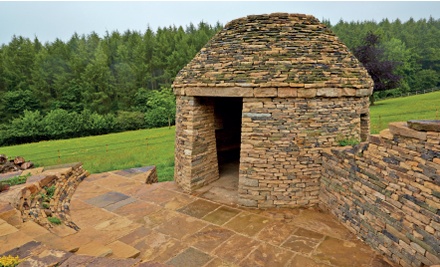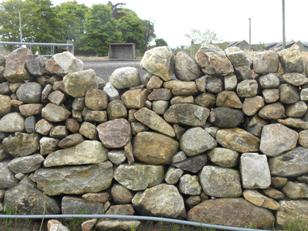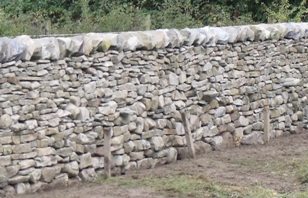Dry Stone Walling in the 21st Century
Richard Love
 |
| Regional variations 1: Galloway ‘dyke’, Loch Dornal, South Ayrshire (Photo: DSWAPL/N Coombey) |
Often when people think about the craft of dry stone walling, they conjure up an idyllic country landscape of irregular field patterns stretching across the Cotswolds, the Yorkshire Dales or the Lake District. These walls must have been there for hundreds of years, they surmise, and have no contemporary relevance and no one to maintain them in their original condition. Even when practising their craft, wallers find themselves being asked by members of the public ‘Isn’t dry stone walling a dying art?’, as if the evidence of their eyes is simply unbelievable.
While the British Isles saw a boom in dry stone walling during the 18th and 19th centuries following the various enclosure acts, dry stone walls and buildings have been constructed in the traditional manner throughout these islands for 5,000 years. Prehistoric sites such as Skara Brae on Orkney demonstrate that whole communities were built using dry stone techniques from very early days and exactly the same methods of construction are used today. Nor do we in the UK have a monopoly on such traditional skills. The craft of dry stone walling has been practised around the world from early times and in some cases these traditions are now being rediscovered and revived.
Considering all the modern techniques now available for enclosing livestock that are cheaper to construct and easier to maintain, the disbelief of the public in the survival of the craft is perhaps understandable. So what is its relevance and status in the 21st century and how does it survive as a construction skill in this country against all the odds?
CONSTRUCTION OR LANDSCAPE CRAFT?
Although no distinction would necessarily have been made between dry stone walls used in buildings and landscape features in the past, today we feel the need to compartmentalise subjects such as education, training and skills into ever smaller boxes for bureaucratic convenience. This has been a problem for dry stone walling over the past few decades and some people, including practitioners of the craft, classify walling as a landscape heritage skill because that is where most of the features are found. Another group, perhaps seeing stones being laid, either in courses or randomly, classify walling as an extension of brickwork and stonemasonry.
In reality, dry stone walling is both of these. However, it is clearly the forerunner to all other modern forms of stone and brick construction because it uses stone in its most natural form, uncut and undressed, as it emerges naturally from the earth.
Indeed most early walls, such as those seen around old monastic foundations for example, were constructed from stone cleared off the ground to allow cultivation and construction of small enclosures for animals. Quarrying came along much later, initially on a small, local scale followed by large industrial pits and quarries.
 |
|
| Regional variations 2: Cotswold wall end (DSWAPL/R Ingles) |
More recently, there has been a move within the construction sector to define dry stone walling as coming under ‘Construction Skills’, the sector skills grouping, rather than environmental conservation. Some years ago a working group was asked to put together a National Occupational Standard (NOS), a prerequisite for developing a craft training programme which the UK government will recognise and support. This NOS now sits in the relevant section of the construction skills framework (‘COSVR567 Build Dry Stone Structures’).
However, many professional wallers prefer to be thought of not as construction workers but as independent craftspeople who work almost entirely in the conservation and heritage sector, repairing and rebuilding existing traditional boundaries. In this way they feel they can maintain their individuality and are not required to abide by what they see as unnecessary bureaucracy.
REGIONAL VARIATIONS
Like other vernacular and traditional construction methods, dry stone walling also has its own regional variations, which are mostly dependent on the geology of the available stone. Walling styles range from the stone-faced earth banks of the Cornish ‘hedge’ and Welsh clawdd, through the more regular sandstone and limestone structures found in the middle and north of England, to the single boulder ‘dykes’ of Galloway in south west Scotland.
Longer and flatter stones readily available in sandstone areas are useful for constructing regularly coursed walls, as well as wall-heads, lintels and stiles. The volcanic, igneous stones of the western and northern fringes of the British Isles led to more randomly built walls and dykes, sometimes with large boulders incorporated into the finished structure. The copestones on top of a wall are the main feature which gives it its distinctive local shape and character (compare the two regional variations illustrated above).
THE CRAFT TODAY
How does the ancient craft of dry stone walling, or ‘dyking’ in Scotland, fit into the modern heritage skills sector? The first point to recognise is that the craft did indeed experience a severe downturn, particularly after the second world war, as farms became more mechanised and there were fewer spare hands to maintain the huge number of agricultural walls.
Walling competitions were instigated before the war to keep the skills alive and eventually, owing to the concern that skills had been dying out, a small group of dykers in south west Scotland established the fledgling Dry Stone Walling Association (DSWA) in 1968. The DSWA is now a charitable organisation, which has its head office in Cumbria and 19 branches around Britain, from the Isle of Skye to Dorset.
The DSWA’s 1,000 members include ordinary members with an interest in the field and 250 professional wallers, most of whom have some level of certification (see below). However, there are many more professionals who have chosen not to register with the DSWA, usually because they already have sufficient work and do not feel the need to put themselves through an examination process to prove their ability. It is therefore difficult to quantify how many craftspeople are making some kind of living as dry stone wallers today: there may be a few hundred, perhaps as many as 1,000.
Many wallers choose to work on agricultural, often grant-aided, repairs and this can provide those in certain areas of the country with a decent living. Others feel the need to stretch their skills by undertaking commissions in private gardens and on commercial projects where more complex features, as well as boundary walls, are needed.
 |
|
| Corbelled stone shelter (Photo: DSWAPL/L Noble) |
Steps, stiles, seats and monuments are often required and display gardens at local and national garden shows now provide the more adventurous wallers with excellent opportunities to showcase their work. The RHS Chelsea Flower Show can offer the craft an international shop window for wallers if garden designers provide encouragement for the imaginative use of stone.
Smaller buildings are also still being made with dry stone techniques: three have been recognised by the DSWA’s Pinnacle Award for outstanding use of dry stone during the past 20 years. Dry stone shepherds’ huts can still be found in Europe (Croatia and France, for example) and dry stone is used to construct dwellings in parts of Nepal.
TRAINING AND TESTING
Most aspiring dry stone wallers start off by attending a one- or two-day weekend training course. These courses are often run by conservation charities but the quality of instruction provided can be of variable quality. Several colleges, particularly in England, provide walling courses run by qualified instructors with recognised walling and teaching certificates. The students can be trained to a sufficient standard to be able to take and pass the Level 1 (initial) and Level 2 (intermediate) certificates, which are timed assessments of entirely practical skills.
DSWA branches also provide training courses, always run by certificated wallers with an appropriate instruction qualification, and arrange regular practical events for members to practise their skills sufficiently to be able to acquire certification by examination.
The qualifications currently available are delivered under the auspices of Lantra Awards and DSWA. Lantra is a sector skills council which has many years’ experience in the land-based and environmental sector. Lantra gave the DSWA’s existing certification system nationally accredited status in 2003. Over 250 students take one or more of these qualifications each year.
The Craftsman Certification Scheme has four levels of qualification, each one requiring the waller to have a greater understanding of the craft and the materials being used. All tests are of a practical nature and most are carried out within a given time period in the presence of an examiner. Those who achieve the status of Mastercraftsman are then eligible to apply to become a qualified examiner. This follows a probationary period and a full assessment of their skills as an examiner during a formal evaluation session under real test conditions.
There are currently 29 Mastercraftsmen and women who are qualified to be examiners, most of them based in the UK.
IS THERE A SHORTAGE OF SKILLED WALLERS?
In England and Wales Lantra provides a modern apprenticeship which allows employees the opportunity to get hands-on experience through a partnership between the apprentice, employer and training provider and leads to a recognised qualification. This is mainly targeted at 16–19 year olds with a lower level of funding available for students aged 20–24. However, within the environmental sector, this has had very little impact on the provision of qualified wallers continuing to practise their craft at a professional level.
In Scotland there are currently no colleges providing dry stone walling training leading to a recognised qualification, although a new modern apprenticeship has been launched this year which incorporates a module in dry stone walling.
 |
|
| Publicly funded road project (Photo: DSWAPL/S Denham) | |
 |
|
| An HLF bursary trainee’s work (Photo: DSWAPL/A Shaw) |
A few years ago the DSWA became sufficiently concerned about the lack of new recruits entering the craft that it made a concerted effort to seek funding for a scheme to boost the training of young people keen to get on the ladder. The Heritage Lottery Fund agreed to support a bursary scheme in 2015 which allowed five trainees aged 19–32 to be placed with experienced working wallers in the north west of England for a period of 18 months.
During this time the trainees have received intensive walling training as well as training in a range of other areas including business management, health and safety, and first aid. The aim is to train this group so that they will have gained their Level 3 certificate at the end of the training period. The project is on course at the moment and, if successful, DSWA believes it could be rolled out elsewhere in the country.
In previous years, ever since it was recognised that these craft skills might eventually disappear, there have been occasional short-term apprenticeship schemes, usually for a year or less and for only one or two participants. Most of these schemes foundered because of the cost, in time and money, to the placement providers. The present HLF scheme costs the experienced wallers little or nothing, and the employer may benefit by gaining a fully trained waller who wishes to work with them beyond the period of the project.
Unlike in other construction trades, most of those who take up walling as a professional job are somewhat older. Consequently, another scheme run by the DSWA and supported by the Prince’s Countryside Fund, targets people up to the age of 40, who are employed or training in rural activities. This scheme offers funding towards an initial training course and a contribution towards the cost of a Level 1 certification test. This has already been taken up by 150 young people around the UK.
The DSWA is also lucky to have had two or three young wallers, who have made great progress to high skill levels, act as young ambassadors for the craft. Two of them have recently been awarded the DSWA’s Pinnacle Award for outstanding craftsmanship for a dry stone, corbelled roof building (see page 106). It is hoped that this will encourage further young people to see the craft as a worthwhile and rewarding career path.
WIDER RECOGNITION OF THE CRAFT
Although dry stone wallers are sometimes employed by mainstream construction contractors, for example to provide boundary walls for new housing estates or feature walls in new commercial developments, the knowledge and capabilities of such wallers are not well known. This has resulted in a knowledge deficit, mainly through lack of awareness and appropriate training, among architects and civil engineers who do not know how to specify dry stone walling features.
Wallers are often presented with specifications for a construction project where the architect or engineer has specified a dry stone wall to be built on a concrete foundation and against reinforced blockwork, when these are clearly not needed. Experienced dry stone wallers are usually not consulted beforehand, possibly because planners do not know who to consult. DSWA is now trying to address this by developing a series of online documents to promote better understanding of dry stone walling among construction industry personnel of all levels.
A corollary to this is the use of inappropriately skilled workers to build large areas of walling on major publicly funded projects, such as alongside motorways and bypasses. DSWA has experience of several past and ongoing projects where many kilometres of walls and dykes have been built to a standard which would disgrace someone with even one week’s properly instructed training. Compare these two images: one from a current publicly funded roads project (above left) and the other from one of the bursary HLF trainees after a few weeks’ experience (above right).
The industry experts usually only get called in after these projects have been finished. Although those commissioning such work do sometimes consult with and receive advice from DSWA before undertaking such large projects, the image demonstrates that unless this work is properly funded and supervised sub-standard work is still being accepted at public expense. Many sections of this wall will no doubt have fallen down by the time you read this article.
A REWARDING CAREER
Dry stone walling is a historical traditional craft which has done much to enhance and define the landscape of Britain. There are around 200,000 kilometres of dry stone walls and dykes stretching across the British landscape, much of it in need of repair. However, the funding for all those repairs is never going to be made available and, in all honesty, is probably not needed. Nevertheless, there are sufficient parts of the countryside where such structures do need to be kept in good order, including distinctive landscape features which will provide work for wallers for centuries to come.
For other wallers, who wish to extend their skills into more distinctive architectural and even artistic features, the craft can offer a most rewarding and satisfying career alongside the other crafts and trades employed in the building conservation sector. There is a place for all levels of waller, male and female, young and old.
It is worth remembering that no one stone is the same as any other and that every job is a new learning experience.



